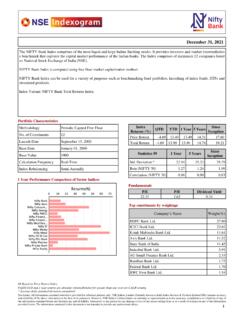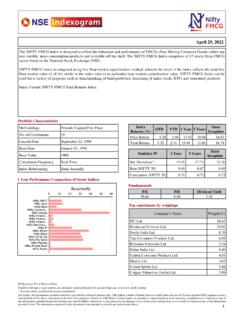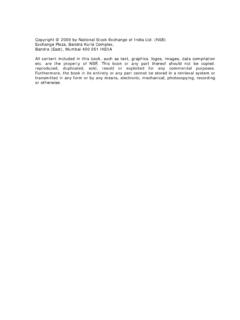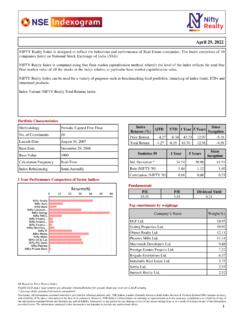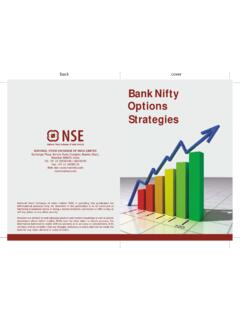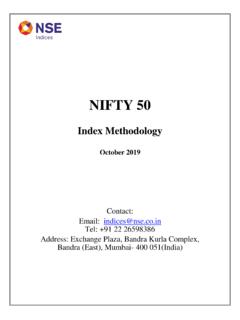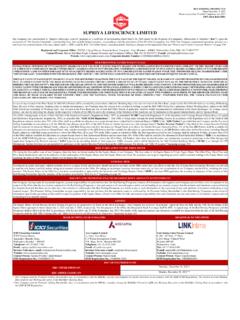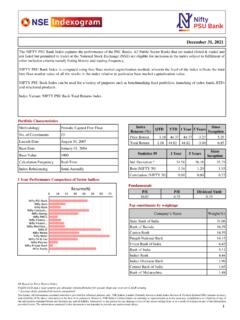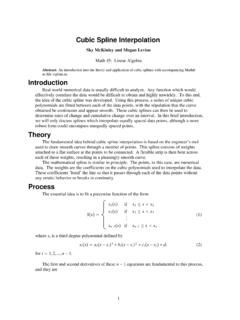Transcription of 1. Volatility Index
1 1. Volatility Index Volatility Index is a measure of market s expectation of Volatility over the near term. Usually, during periods of market Volatility , market moves steeply up or down and the Volatility Index tends to rise. As Volatility subsides, Volatility Index declines. Volatility Index is different from a price Index such as NIFTY. The price Index is computed using the price movement of the underlying stocks. Volatility Index is computed using the order book of the underlying Index options and is denoted as an annualised percentage. The Chicago Board of Options Exchange (CBOE) was the first to introduce the Volatility Index for the US markets in 1993 based on S&P 100 Index option prices. In 2003, the methodology was revised and the new Volatility Index was based on S&P 500 Index options. Since its inception it has become an indicator of how market practitioners think about Volatility . Investors use it to gauge the market Volatility and base their investment decisions accordingly.
2 2. India VIX*. India VIX is a Volatility Index computed by NSE based on the order book of NIFTY Options. For this, the best bid-ask quotes of near and next-month NIFTY options contracts which are traded on the F&O segment of NSE are used. India VIX indicates the investor s perception of the market s Volatility in the near term it depicts the expected market Volatility over the next 30 calendar days. Higher the India VIX values, higher the expected Volatility and vice- versa. 3. India VIX :: computation methodology India VIX uses the computation methodology of CBOE, with suitable amendments to adapt to the NIFTY options order book. The formula used in the India VIX calculation is: where: India VIX/100 India VIX= x 100. T Time to expiration Ki Strike price of ith out-of-the-money option; a call if Ki > F and a put if Ki < F. Ki Interval between strike prices- half the distance between the strike on either side of Ki: * VIX is a trademark of Chicago Board Options Exchange, Incorporated ( CBOE ) and Standard & Poor's has granted a license to NSE, with permission from CBOE, to use such mark in the name of the India VIX and for purposes relating to the India VIX.
3 1.. (Note: for the lowest strike is simply the difference between the lowest strike and the next higher strike. Likewise, for the highest strike is the difference between the highest strike and the next lower strike). R Risk-free interest rate to expiration Q(Ki) Midpoint of the bid ask quote for each option contract with strike Ki F Forward Index taken as the latest available price of NIFTY future contract of corresponding expiry K0 First strike below the forward Index level, F. Some of these symbols are further explained below. Time to expiration (T). India VIX calculation measures the time to expiration in years, using minutes till expiration. The time to expiration is given by the following expression: T = {MCurrent day + MSettlement day + MOther days}/ Minutes in a year Where, MCurrent day = Number of minutes remaining until midnight of the current day (from computation time upto am). In the hypothetical example provided in the subsequent pages, it is pm up to am MSettlement day = Number of minutes from midnight until closing hours of trading ( 3:30.)
4 On expiry day MOther days = Total number of minutes in the days between current day and expiry day excluding both the days In the hypothetical example provided in the subsequent pages, the near month option has 9. days and next month option has 37 days to expiration. Accordingly, the time to expiration (T1) for the near month and (T2) for the next month works out to: T1 = {510 + 930 + 11520) / 525,600 = T2 = {510+ 930 + 51840) / 525,600 = India VIX uses put and call options in the near and next month expiration, in order to bracket a 30-day calendar period. It may be noted that CBOE VIX rolls to the next and far month 2. with less than a week to expiration. However, with 3 trading days left to expiry, India VIX. rolls to the next and far month. Risk free Interest Rate (R). The relevant tenure of NSE MIBOR rate ( 30 days or 90 days) is being considered as risk- free interest rate ( R1= and R2 = , in case of the hypothetical example considered subsequently) for the respective expiry months of the NIFTY option contracts.}}
5 Determination of forward Index level, F. Volatility Index is computed using mainly the quotes of the out of the money (OTM) options. The strip of OTM option contracts for computing India VIX could be identified if the at-the- money (ATM) strike is identified. In case of CBOE, the forward Index level is arrived at by using the strike price at which the absolute difference between the call and put prices is minimum. NSE has an actively traded, large and liquid NIFTY futures market. Therefore the latest available traded price of the NIFTY futures of the respective expiry month is considered as the forward Index level. In the hypothetical example given in the subsequent pages, the latest traded price of NIFTY future for near month (F1) is taken as 5129 and next month (F2) is 5115. This helps in determining the ATM strikes and thus the OTM strikes for the purpose of computation of India VIX. Computation of K0. K0 is the strike price just below the forward Index level.
6 This is considered as the at-the money strike (K0). In the hypothetical example discussed below, given the value of F1 and F2, K0 = 5100 for both near and next month contracts. The next step is to consider the order book for selecting the strip of OTM options for both near and next month. 4. Computation of India VIX using an example Consider the following extract of the best bid and offer of the order book of various strikes available for trading in respect of near month NIFTY options. Similar extract shall be taken for the next month as well. To explain the methodology of selection of the strikes, application of cubic spline , etc., the example is initially worked out with the near month options. 3. Call Bid Call Ask Put Bid Put Ask Strike (Rs.) (Rs.) (Rs.) (Rs.). 3800 3900 4000 4100 4200 4300 4400 4500 4600 4700 4800 4900 5000 5100 5200 5300 5400 5500 5600 5700 Selection of option contracts to be used in the calculation As stated earlier, India VIX is computed using mainly the quotes of the OTM options.
7 All call options contracts with strike prices greater than K0 and all put option contracts having strike prices less than K0 are therefore considered for this purpose. In the example considered above, in respect of the near month, quotes were available for strike prices from 3800 to 5700. with a strike price interval of 100. So in respect of the call options, the quotes of seven strike prices namely, 5100, 5200, 5300, 5400, 5500, 5600 and 5700 (including the ATM strike) are considered for the computation. Similarly, in respect of put options, quotes of 14 strikes from 3800, 3900, etc. to 5100 (including the ATM strike) are considered. Similar exercise shall be done for the next month options as well. Computation of Mid-price Q(Ki). As seen above, for computation of India VIX, Q(Ki), the midpoint of the bid ask quote for each option contract with strike Ki , is required. In respect of the ATM strike, the average of the mid prices of both call and put options are considered.
8 Before proceeding further with the computation of India VIX, it is checked to see whether the quotes are available/ appropriate. 4. The strikes with spread greater than 30% of the mid price (of the bid and ask) are considered as not appropriate. The spread is computed as: Spread = (Ask Bid) / Average of Bid and Ask Such of those strikes which are identified as not appropriate as mentioned above, or for which, no quotes are available in the order book, mid-quotes are computed using cubic spline , subject to other conditions explained below. cubic spline Fitting The table given below provides the mid price and spreads of various strikes of call and put options. It may be observed that in respect of four relevant strikes (three for puts and one for call), as highlighted, the quotes are not considered appropriate. Call Call Call Call Put Put Put Put Strike Bid Ask mid spread Bid Ask mid spread (Rs.) (Rs.) (Rs.) (Rs.) (Rs.) (Rs.). 3800 2% 22%. 3900 2% 78%. 4000 0% 19%.
9 4100 1% 32%. 4200 2% 18%. 4300 1% 34%. 4400 2% 5%. 4500 1% 4%. 4600 4% 1%. 4700 2% 4%. 4800 2% 2%. 4900 1% 1%. 5000 0% 0%. 5100 0% 0%. 5200 1% 1%. 5300 0% 3%. 5400 1% 7%. 5500 14% 15%. 5600 30% 5%. 5700 35% 5%. 5. The mid price in respect of these strikes shall be computed using cubic spline . The variation of option quotes against strikes is not linear. Therefore the quotes cannot be fitted using a simple linear interpolation. Hence, the option quotes can be fitted using a polynomial function like cubic spline . India VIX computation uses natural cubic spline for this purpose. This method considers the mid quotes of the other NIFTY option contracts and interpolates for the quotes which are not appropriate/available. Selection of knot points In the table given above for the near month, four strikes were identified and highlighted. In respect of these four strikes, as stated before, cubic spline shall be applied, wherever possible. For application of cubic spline , knot points are required on both the sides of the strike for which fitting is to be done.
10 In such of those cases where the strike does not lie within the range of the knot points, cubic spline cannot be used. Strikes remaining after filtration ( strikes which are available or appropriate) are known as knot points. It may be observed that in respect of the call options the highlighted strike 5700 does not lie within the range of the knot points. Hence in this case cubic spline could not be used. In respect of all the other highlighted strikes, cubic spline shall be used. Equations of cubic spline and the relationships between the various terms The general form of the cubic equation in term of coefficient of variable is given as: S j ( x) a j ( x x j ) 3 b j ( x x j ) 2 c j ( x x j ) d j :: Equation (1). Where, Sj(x) represents the fitted value, x j is the lower limit of each sub-interval (a subinterval consists of two consecutive knot points) and aj, bj, cj and dj are the coefficients and constant in the equation. In the instant case, taking the example of the highlighted strike of the put option 3900 (x), if we apply the Equation (1), Sj(x), the mid quote for the strike 3900, shall represent the fitted value of this strike, and x and x j shall be 3900 and 3800.

